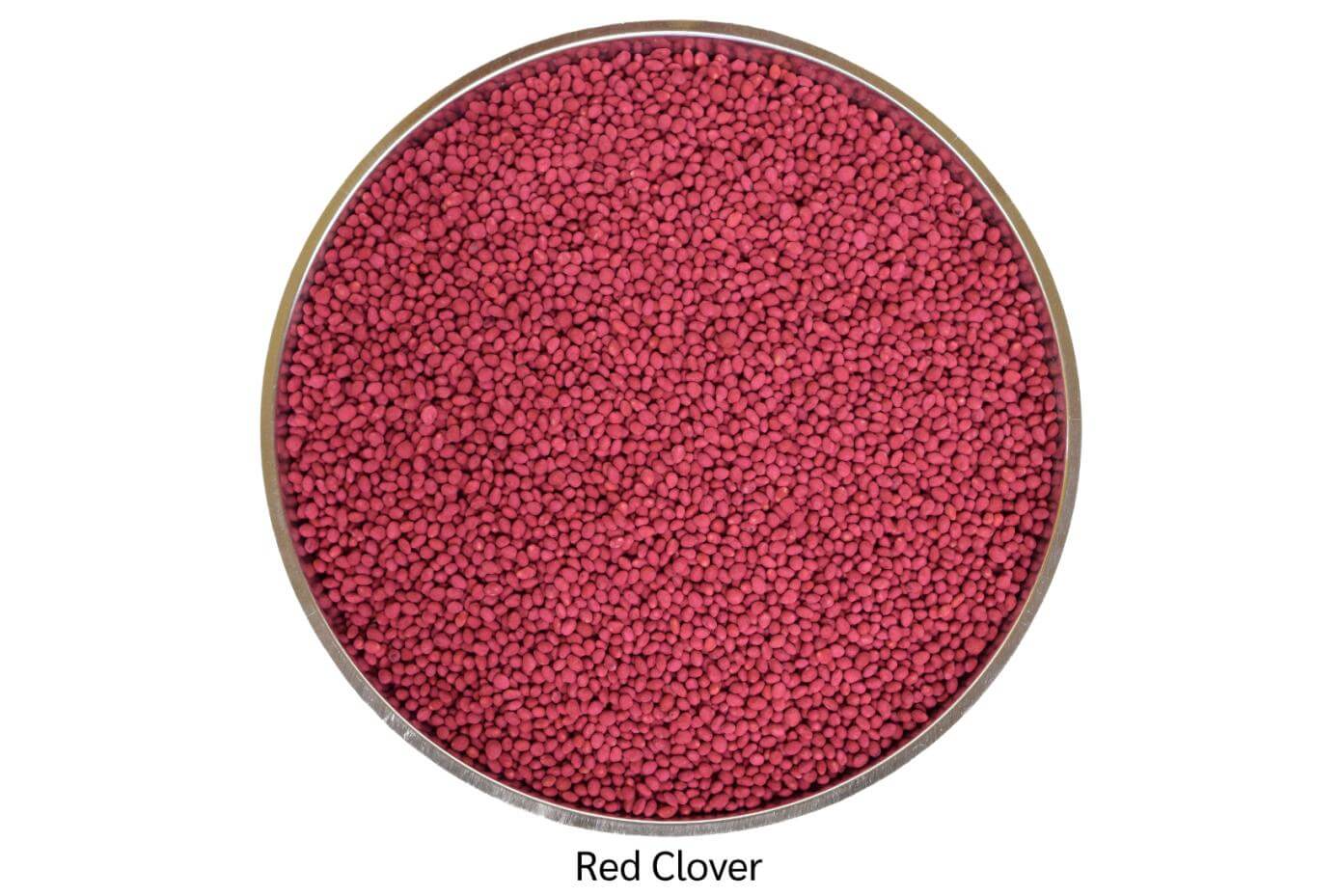Red Clover Trifolium Pratense L.
One of the oldest true clovers to be sown, red clover has many uses, including hay and grazing. It is also an excellent soil builder and wildlife food source.
A long history.
Red clover is one of the oldest true clovers to be sown and used as livestock feed and crop rotation. It became integral in the development of both European and American agriculture. Originating in Asia Minor and southeastern Europe, it easily spread as an important sown crop throughout Europe, then in England, and finally in America. As an outward sign of this historical spread, its flower is the national flower of Denmark and the state flower of Vermont!
Types of red clover.
In North America, red clovers are grouped by flowering type. Early flowering types are known as “medium red”. Medium red types are known for producing 2-3 hay crops per year, are normally biennial or demonstrate a short-lived perennial growth habit. In the lower South, they generally act as an annual. Late flowering types are known as “mammoth” or “single-cut”. The late flowering mammoth types are nicknamed “single-cut” because they produce only one major hay crop per year.
Distinguishing marks.
Red clover has hairy hollow stems and leaves, and magenta flowers borne in compact seed head clusters. Each leaf has three oval leaflets. The 2” long leaflets have a white or light green chevron. Red clover plants grow from crowns. Red clover has larger seed than white clover giving it better seedling vigor than its white flowered cousin. This seedling vigor also facilitates drilling it into existing grass pastures.
Grows well, even in the heat.
Red clover prefers soils with a pH of 5.8-7.0. Red clover is often grazed, but is not tolerant of continuous close defoliation; rotational stocking is best. Red clover also requires good soil moisture, has good heat and drought tolerance, but is not considered as tolerant of wet conditions like other clovers, such as white and alsike.
Good for grazing, hay and cover cropping.
Red clover is commonly used for hay, grazing, weed suppression, and soil building. Its extensive root system and deep tap root can penetrate multiple feet, providing access to nutrients and moisture over other more shallow-rooted clovers.
Although it is still primarily used for both hay and grazed pasture, in the grand tradition of ley farming, it is re-establishing itself as a green manure legume for crop rotation and cover cropping systems. Its flowers have even been promoted recently for use as herbal tea with possible medicinal qualities.
Nitrogen producer.
Red clover can produce up to 4 tons DM/A and fixes up to 150 lb. N/A. In order to achieve optimal nitrogen fixation ability, red clover needs to be inoculated with Rhizobium leguminosarum biovar trifolii. This is best achieved with Nitro-Coat®.
What we recommend.
While common VNS, or variety not stated medium red clover may be readily available, we recommend using GA-9908 when improved grazing performance, better disease resistance and extended longevity are desired. This is especially true in southern environments. Learn more about GA-9908.
Red Clover Specifications
Planting
- Zones
- Humid or irrigated regions of zones 3-8; acts as annual in zone 9
- Longevity
- Biennial
- Ease of Establishment
- Excellent
- Seeds/lb
- 270,000
- Seeding Rate - Straight
- 12-15 lbs/ac
- Seeding Rate - Mix
- 8-10 lbs/ac
- Seeding Time
- Fall (October - November) or late winter to early spring (February - April)
- Seeding Depth
- 1/4-3/8"
- Seeding Method
- Broadcast or drilled (preferred)
- Method of Killing/Suppression
- Mowing; grazing; chemical
- Optimal Germination Temperature
- Night temperatures > 40°F
- Seedling Emergence/Vigor
- Good
- Reseeding Potential
- Good
- Root Type
- Tap
Usage
- Grazing Potential
- Good
- Hay Potential
- Excellent
- Use with Wildlife
- Good
- Use in Orchards
- Good
- Use with Row Crops
- Good
- Use with Other Grasses/Legumes
- Excellent
- Bees/Beneficial Insects
- Good
- Compaction Control
- Good
- Erosion Control
- Good
- Weed Suppression Potential
- Good
- Green Manure/Cover Crop Use
- Excellent
- Spreading Capability
- Fair
- N Contribution Potential
- Good
- DM Potential
- Excellent
- Forage Quality
- Good
- Harvest Time Frame (late/early/year-round)
- Year-round
- Number of Harvest/yr
- 3-4 per year
- Other Comments
- Cut hay at early bloom stage; practice rotational grazing as continuous grazing detrimental to persistence.
Tolerance
- Bloat Risk
- High
- Disease Resistance
- Poor; many diseases such as powdery mildew, anthracnose, viruses can be a problem
- Insect/Nematode Risk
- Moderate
- Cold Tolerance
- Excellent
- Traffic Tolerance
- Good
- Heat Tolerance
- Good
- Drought Tolerance
- Good
- Shade Tolerance
- Good
- Dry Soil Tolerance
- Good
- Wet Soil Tolerance
- Fair
- pH Range
- 5.8-7.0
- Required Fertility (P,K, other nutrients)
- P, K, Ca, Mg needed; minor especially Mo, B also needed
